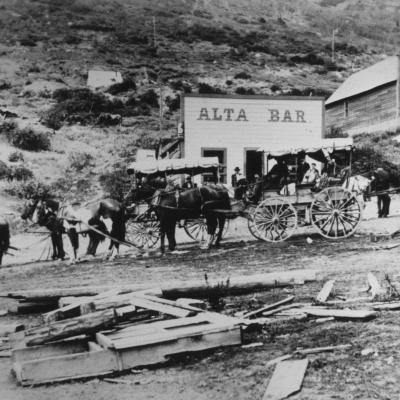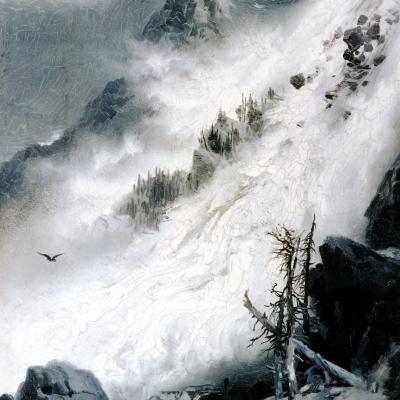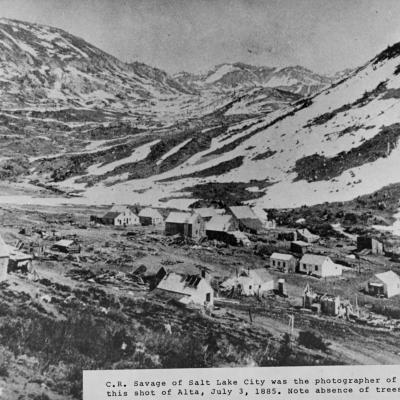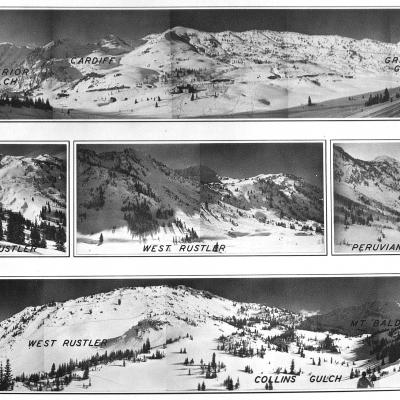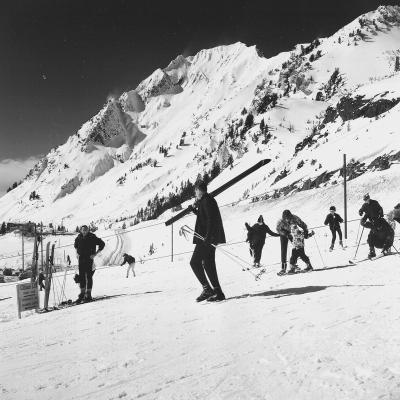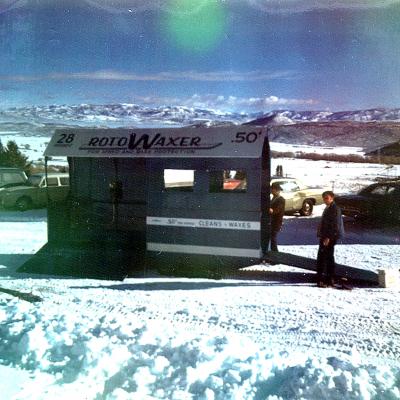Alta Ski Area
By Kallin Glauser
A Brief History of Alta
In 1865 the first verified mining claim was staked in Alta, resulting in the founding of the prosperous mining town. By 1872 Alta had 150 buildings, as well as several thousand seasonal workers and a thriving economy. As silver deposits in the Emma Mine ran out and the town suffered various natural disasters which destroyed many of the original buildings, the human settlements were abandoned. In 1904, the discovery of mineral deposits in Little Cottonwood Canyon once again resulted in a mining boom and a period of growth lasting three decades. With the onset of the Great Depression, Alta’s mines were shut down and the population sharply declined, leaving “Mayor” George Watson the sole inhabitant by the 1930’s.
In order to ease the burden of back taxes owed on his mining claims, Watson donated 1,800 acres of surface rights to the United States Forest Service for use as a ski area. Due to the need for housing and mining support, virtually all the trees in Alta had been cut down. On the recommendation of Alf Engen, the Civilian Conservation Corps (CCC) planted hundreds of trees to replenish the area's deforested slopes, resulting once again in a lushly covered canyon.
The ski area opened in 1938 and the Alta Lodge along with the Collins chairlift began operations in 1939. During its first year of operation, the price of a chairlift ride was 25 cents, or $1.50 for a full day. The 1940s experienced an impressive amount of growth, resulting in the opening of the Rustler (1947) and Peruvian lodges (1948), the beginning of the Alta Ski Patrol, the inception of an avalanche research center, and the training of Company B 503 Parachute Battalion for service in World War II. Alta is central in the history of American skiing, and will be celebrating its 81st season in 2019.
Margie of the Wasatch
As the Alta Ski Resort grew in popularity, ski enthusiasts became interested in promoting Utah's ski industry. Many began creating films which showed off the canyon's great skiing and natural beauty. The Engen brothers were especially interested in these promotional films and helped to create both Ski Aces and Margie of the Wasatch during the 1940s. “Margie of the Wasatch” was filmed at Alta Ski Area in Little Cottonwood Canyon, which showcases the Wasatch Mountains and the lessons, facilities, and services available at the resort.
The 41 minute film is centered around the efforts of two ski instructors who aspire to gain the affection of the beautiful ski tourist, Margie. The film begins with ski instructor Sverre Engen—national ski jumping champion, Alta ski school director, and Utah ski industry and ski patrol pioneer—buying a snowflake pin to bring him luck in wooing Margie. As the story progresses, however, Sverre has persistent bad luck, and the other ski instructor, Bert, spends time with Margie instead. The film ends with Sverre throwing his goodluck pin into the snow, and Margie’s ski miracuously sliding down the mountain to his feet. Sverre goes to return it, and the film concludes as Margie, overjoyed at the return of her ski, hugs and kisses him. The two ski arm in arm back to the lodge, and the audience is left with a beautiful view of the canyon.
Alta Finding Aids
Alta is just one of many ski areas with a wealth of primary sources available in the Utah Ski Archives. There are multiple photo collections with materials documenting Alta throughout the years, as well as manuscript collections with advertising materials and other documentation.
Selected Finding Aids and Digital Collections
Alta Ski area collection, circa 1970s (finding aid) - Alta, Utah, was established in 1871 as a result of mining operations in nearby Little Cottonwood Canyon. As mining operations ceased, the town declined. During the 1930s, the U.S. Forest Service purposed the area be turned into a ski area and hired noted skier, Alf Engen, to do a survey. In 1937, Joe Quinney, along with other prominent local businessmen, formed the Utah Winter Sports Association and oversaw the creation of the Alta ski area. Alta Ski Resort opened to skiers for the first time in January 1939.
Jim Shane Alta, Utah collection, 1948-1985 (finding aid) - Jim Shane, an avid skier and electrical engineer, was an Alta ski patrolman during World War II. Later, he became divisional chairman of the National Ski Patrol System for the intermountain area. In 1962, he built the Gold Miner's Daughter Lodge at the base of the Alta ski area to provide services for skiers who were either injured or in need of food, warmth, or repairs. The lodge was named after an infamous saloon from Alta's early mining days. Shane and his family were active in the daily management of the Gold Miner's Daughter Lodge and the Alta community. The Jim Shane Alta, Utah collection (1948-1985) contain clippings and promotional material concerning the town of Alta, Utah. Included are photocopies of news photographs and articles regarding skiing activities, as well as human interest stories on early University of Utah ski instructors, Alta history, the expansion of the Gold Miner's Daughter Lodge, and the propane explosion at the lodge in 1985.
Jean and Wilburn Pickett papers, 1961-1998 (finding aid) - The Jean and Wilburn Pickett papers (1961-1998) contain correspondence, entry applications, score cards, news clippings, posters, trail maps, brochures, and editions of the Alta Powder News, detailing both the history of Alta, Utah, and Alta's Gelande ski jump competitions as well as other intermountain ski racing and jumping events. Jean and Wilburn Pickett were associated with skiing at Alta for many years. Wilburn began publishing the Alta Powder News in the 1960s. After his death in 1983, Jean Pickett became the editor and chief writer for the newsletter.
Wilburn and Jean Pickett Photograph collection (digital collection) - Over 1000 photos of Alta ranging from the 1890s-1980s.
Alta Photograph Collection (digital collection)

